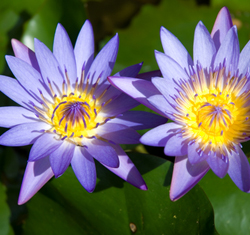
A garden pond
is a wonderful feature of any garden. You have a dream of adding a
garden pond to your backyard retreat. You love the sound of a waterfall
and the idea of a fresh water pond right outside your home. But the
idea of installing a garden pond can be daunting. With the following
instructions, you will learn how to install a garden pond with very
little difficulty.
First, you must choose the placement of your garden pond. You don’t
want to place the pond too high, as it would be unlikely that a pond
would form in a high place. But neither is it a good idea to put it
in the lowest part of the yard, as the pond might flood during rainy
days. Try to choose a spot that would look natural and if you want
a waterfall, you can build a rock outcropping if there isn’t
one naturally.
When choosing the shape and size of your garden pond, you will want
to make an outline with either spray paint or chalk. When you begin
to dig your hole, you will want to dig at least 2 to 3 inches outside
this line. If your pond is deeper than 2 feet, you might require a
permit from the city.
The next step will be to choose a liner. A flexible liner is best
as it is less expensive and can form to just about any shape or size.
Look for an EPDM (Ethylene Propylene Diene Monomer) liner. This is
recommended by most experts for its resistance to cold weather, non-toxic
ingredients, and long lifespan. It is also less expensive than many
other liners. After you finish digging your hole, you will place about
2 inches of sand in the bottom to assist with making a flatter surface.
You then place your liner in the hole, making sure it is level, and
there are no roots or other sharp objects below it.
Next, you will want to fill the pond with water and make sure that
it is chlorine-free. Cut away the excess liner, but keep the extra
pieces for patching if necessary. Next, you will want to install a
filter and pump in your garden pond. First, decide which type of filtration
system you will be using. If you have a small to medium sized pond,
you can use a submerged filter. If you have a larger pond, then an
external filtration system must be used.
Place the submerged filter where the intake will not be obstructed
with debris and mud. If using an external filter, place on a solid,
flat surface. Place the “exhaust hose”, the hose that
is leaving the filter, under water at the bottom of the pond, or hook
it up to a fountain or waterfall. You can find inexpensive floating
fountains or waterfall pieces that will really add beauty to your
garden pond.
Make sure that the outlet that you use is a ground fault circuit
interrupter. This type of outlet will shut down if it senses a leak
or a fault, thus protecting the fish and animals in your water from
electrocution. You can also assist Mother Nature with the nitrogen
break down cycle by adding bacteria eating foam or other biological
medium for your garden pond.
Your garden pond is now ready to incorporate the decorative pieces
such as rocks, fish, and plants. Once you have finished the installation,
now comes the fun part. You get to sit back and relax and enjoy the
beauty of your garden pond.